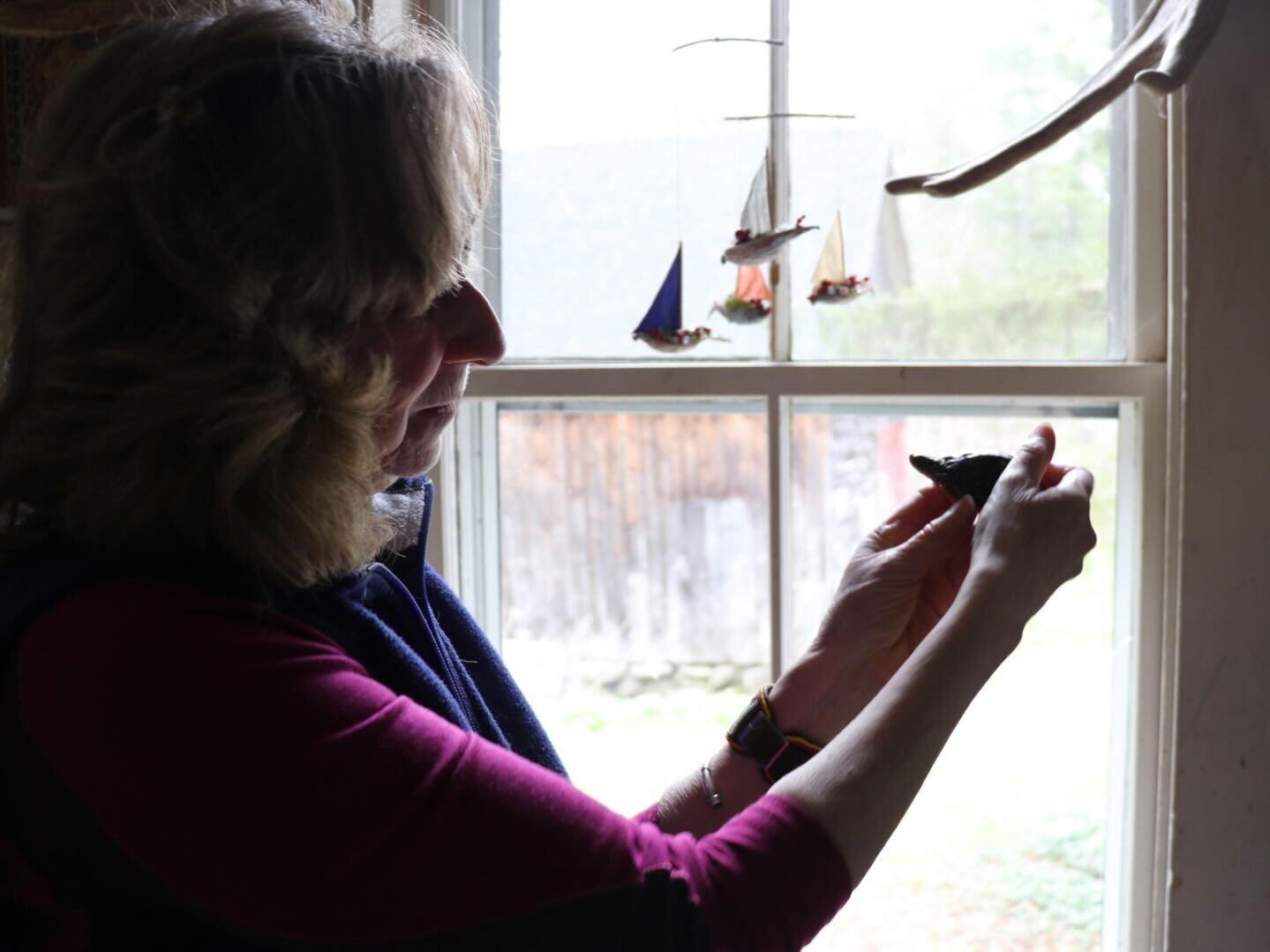- Tags:
- Something Wild,
- Wildlife

Sy Montgomery with a turtle. (Photo: Zoey Knox, NHPR)
Occasionally Something Wild takes a field trip, and recently we got to hang out in Hancock with New Hampshire nature writer, naturalist and children's book author, Sy Montgomery. This episode is part of our three-part series, “Something Wild: A glimpse into the heart, soul, and science of animals with Sy Montgomery."
“We could have talked with Sy for days! She has extraordinary insight,” says Something Wild co-host Dave Anderson. “She’s an animal empath. Her gift is getting into the heart and soul of an animal, from octopuses to hummingbirds to pink dolphins and tigers.”
“She captivates humans, too!” says Chris Martin, Something Wild co-host. “That’s what makes it so special to spend time with Sy and the animals she loves. We hope this series will give listeners a glimpse into Sy’s animal-centric world.”
As we walked into Sy’s house, we were greeted by a large painting of a colorful painted turtle. What a coincidence! The artwork is by artist Rosemary Conroy who also happens to have been one of the original hosts of Something Wild.
Sy’s office is packed to the brim with books, lots of them hers –she’s written over 30! It was hard not to get distracted by all the curious artifacts from her extensive research and travels.
“We’re in the naturalists’ lair here, and every place you look there’s stuff about the natural world,” says Chris.
Sy offers to show us an octopus beak. “Not everyone has one of these,” she says.
In the corner of her office is a plastic tub with some water and rocks and three active turtle hatchlings…Blanding's turtles. Sy has been raising them to be released later in the Spring when they are less vulnerable, as part of a New England Zoo and Mass Wildlife program. Blanding's turtles are near the top of the list of New England’s most critically endangered animals.

Sy introduces us to her charges. “Little angel. Look at you. Here's the biggest one, this is Blandeen. Hi, honey. Come on, cutie. So, you know a frog can't eat her.”
Bullfrogs eat turtle hatchlings?
“Yes,” says Sy. “You know, a bird can eat them, a raccoon can eat them. An otter could eat them. A lot of things could still happen, but they're bigger. So they have a head start. And they found for the Blanding's, which are endangered, that they have a 30-fold increase in survivorship. Thirty-fold! And the eggs themselves are so vulnerable. Even trees will eat them. Tree roots will go into the nest and steal their moisture.”
Dave observes that this may be the first time on Something Wild that trees were referred to as villains!
Increasing each turtle’s chance of survival is a huge advantage. To get there, Sy tends these hatchlings for nine months.
“I give them turtle pellets and I give them fish,” says Sy. “ And what they really love is dried shrimp. I mean, who doesn't love shrimp, right? It's like potato chips for them.”
There are four particularly rare turtles in NH - Blanding's Turtles, Spotted Turtles, Wood Turtles and Box Turtles. Blandings are about 7-9 inches fully grown, and have yellow speckles and streaks on their tall, domed, hard upper shell, also called the carapace.
But the most distinctive thing about the Blanding's turtle is the yellow throat and chin.
The New England Zoo says there may be fewer than 3,000 Blanding’s turtles left in the northeast.
Blanding’s turtles overwinter in marshes, swamps, and ponds. In late May or early June, they travel to favored nesting sites located in sandy soils along sunny powerline corridors, roadsides and pastures where they lay 8-10 eggs. Vernal pools give them places to rest and hide along the way.
Since they use a variety of habitats, and travel between them, large, undeveloped areas are critical for their long-term survival. And as with all turtles, crossing roads is a major risk.
Sy is clearly attached to her tiny office-mates. But are they attached to her, after nine months of hand-feeding? What happens when they’re released back into their native habitat? Do they now see humans as a source of food?
“No, they go right back to wild turtle behavior,” says Sy. “Three hundred million years of evolution tells them, the ancestors tell them, what to do. They know that they're not in a tank anymore. But what is very sweet, and this happens when you release them… this is uncommon, but you do see it. And I have seen it. You release them, and sometimes they swim out, and then they swim back, and they pull their heads out of the water and look at you standing on the bank…bless their little hearts.”
In upcoming shows, we’ll learn more about Sy’s experiences raising orphaned hummingbirds, and visit with her friend and neighbor, illustrator and turtle-whisperer Matt Patterson. “And you'll meet Fire Chief,” says Sy. “I have his picture on my desk like normal people have their children.”
Fire Chief is a whopping 42-pound snapper that Matt and Sy are helping rehabilitate after he was hit by a car.
Something Wild is a partnership of the Forest Society, New Hampshire Audubon, and NHPR.
